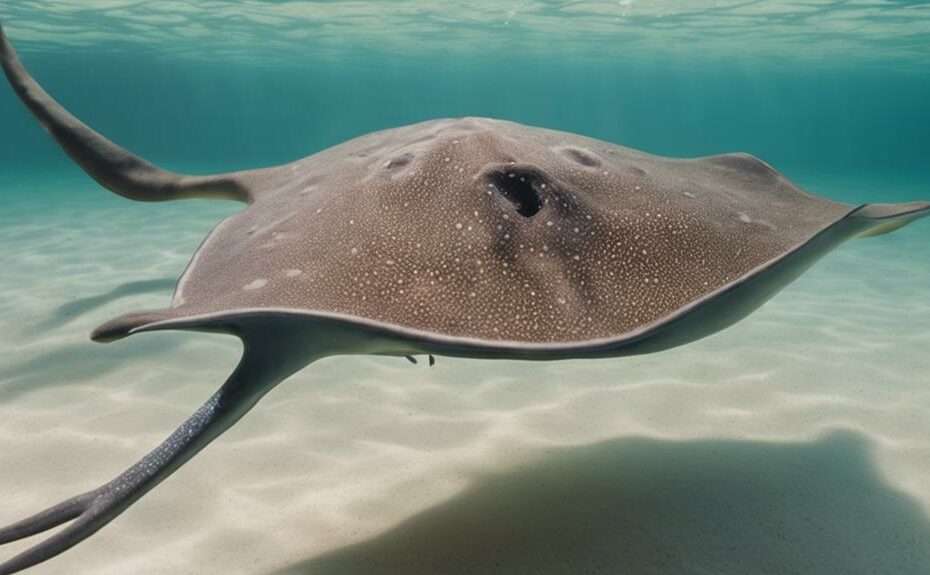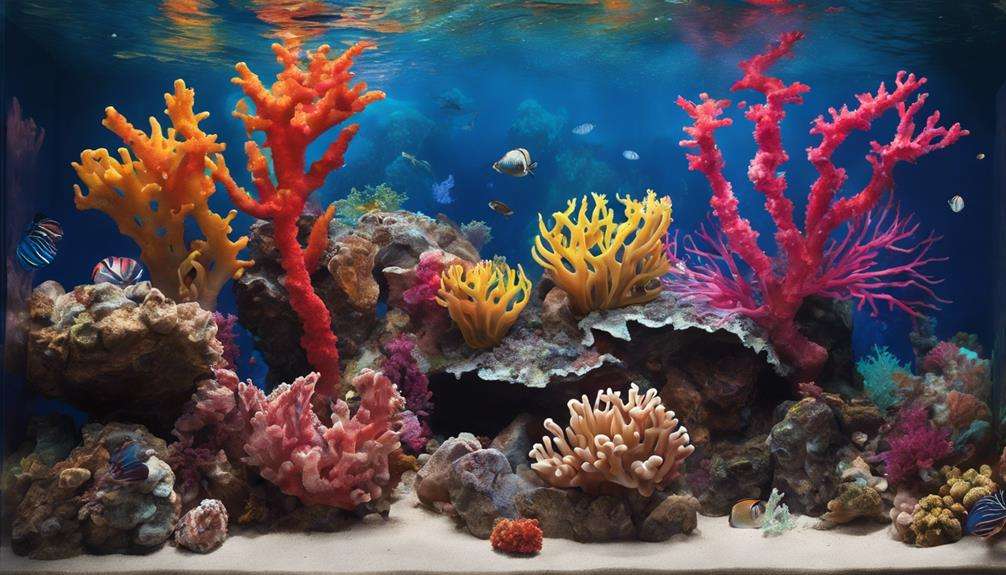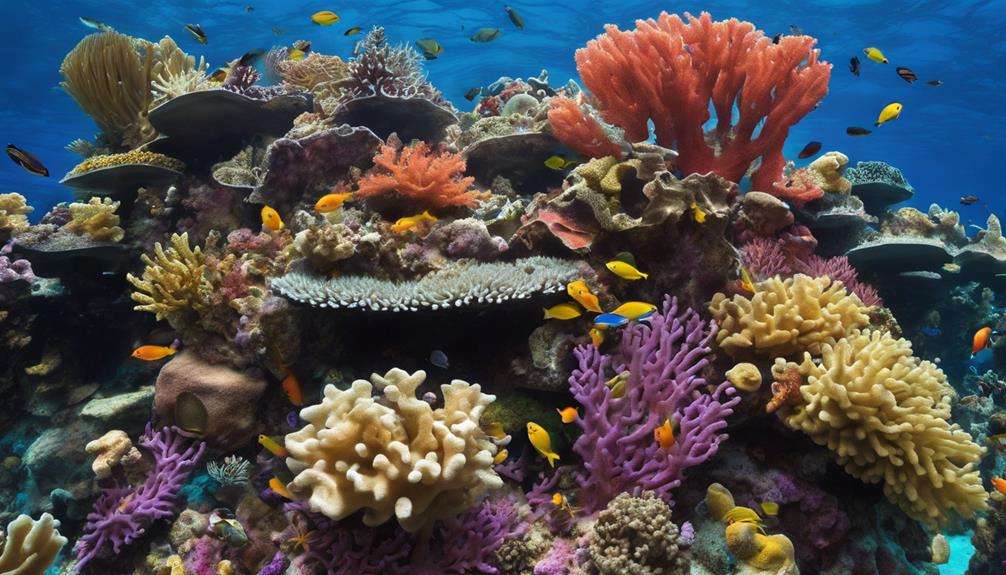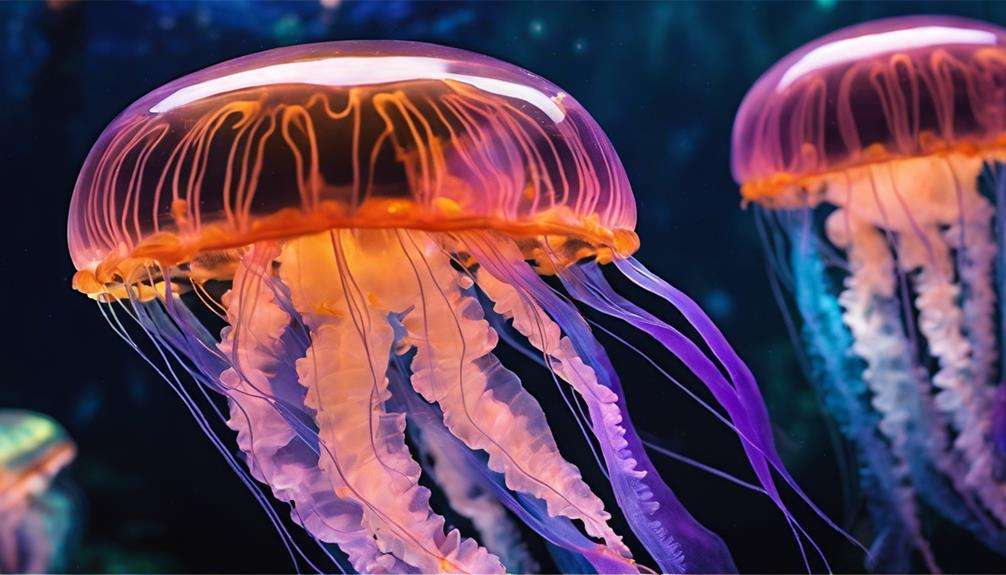Freshwater stingrays might surprise you with their intriguing characteristics. From their unique carnivorous diet to their fascinating wing flapping movement, these creatures hold secrets waiting to be uncovered.
Have you ever wondered about the relation between freshwater stingrays and sharks? Stay tuned to discover more enthralling facts about these elusive creatures that lurk beneath the waters.
Key Takeaways
- Freshwater stingrays have venomous spines for hunting and defense.
- Female stingrays grow larger and have longer lifespans.
- Stingrays display unique swimming behaviors with wing-like fins.
- Their diet includes small fish, crustaceans, and mollusks, contributing to ecosystem balance.
Carnivorous Diet
Freshwater stingrays mainly maintain a carnivorous diet, actively consuming small fish, crustaceans, and mollusks to meet their nutritional needs. This predatory nature is a key aspect of their survival in freshwater environments. Utilizing their strong jaws, freshwater stingrays crush and ingest their prey efficiently, showcasing their role as skilled predators.
Their diet consisting of various aquatic organisms highlights their position both as predators and prey within the ecosystem. By preying on smaller fish, crustaceans, and mollusks, freshwater stingrays help regulate the population of these species, contributing to the balance of the aquatic food chain.
Studying the carnivorous diet of freshwater stingrays is essential for understanding their feeding behaviors and nutritional requirements, important aspects for conservation efforts aimed at protecting these fascinating creatures. The intricacies of their diet shed light on the intricate relationships and dependencies present in freshwater ecosystems.
Wing Flapping Movement
Moving gracefully through freshwater environments, freshwater stingrays showcase a unique swimming behavior characterized by wing flapping motions similar to birds. Their pectoral fins, which are structured like wings, enable them to elegantly navigate the waters. The wing flapping movement serves a vital role in helping freshwater stingrays propel themselves forward and maneuver efficiently.
By utilizing this distinctive swimming behavior, freshwater stingrays can stand out from other aquatic creatures in their habitat. Observing their wing flapping movement highlights the grace and agility these stingrays possess in their natural surroundings. This specialized swimming technique allows them to glide through the water with precision and control, showcasing their adaptability to their freshwater environment.
The rhythmic flapping of their pectoral fins not only aids in their movement but also adds to the mesmerizing beauty of these fascinating creatures as they swim effortlessly through their underwater world.
Relation to Sharks
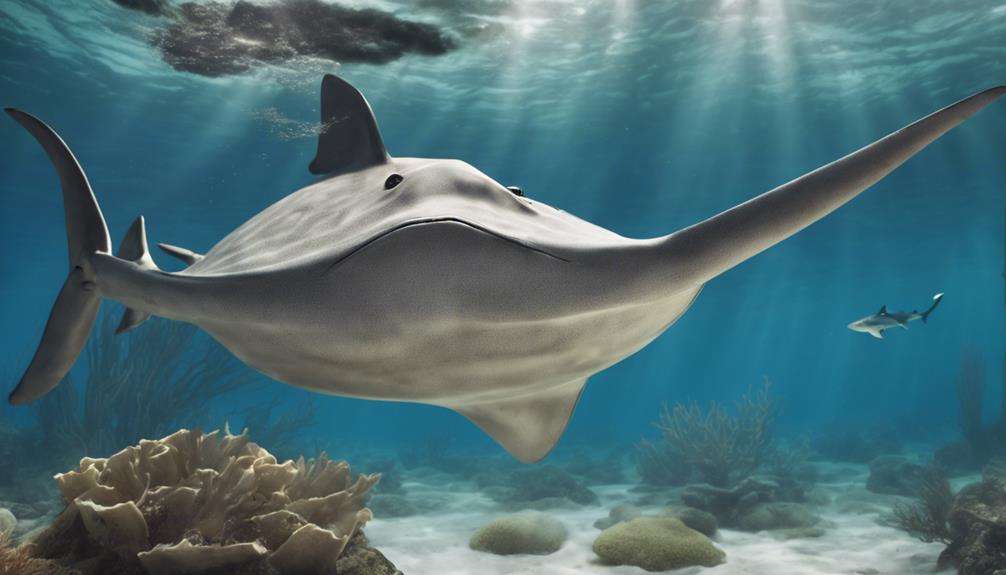
Closely related to sharks, freshwater stingrays share significant anatomical and evolutionary connections within the class of Elasmobranchs. Both species possess cartilaginous skeletons, providing them with a lightweight yet durable framework that aids in swift movements through the water. This skeletal structure allows for flexibility and agility, essential for maneuvering their aquatic environments with precision.
When examining the anatomy of freshwater stingrays, their flattened bodies and specialized adaptations can be traced back to their shared evolutionary history with sharks. The similarities extend beyond their skeletal composition to include features such as multiple gill slits for efficient respiration and advanced sensory systems vital for hunting and detecting prey. These commonalities highlight the intricate relationship between these two fascinating marine creatures and offer valuable insights into their evolution and ecological roles.
Fully Developed Babies
Freshwater stingrays have a unique birthing process where they give birth to fully developed live young, known as pups.
These pups are born self-sufficient, requiring no further care from the mother.
This reproductive strategy guarantees the survival of the offspring in the challenging freshwater environment.
Unique Birthing Process
Exhibiting a remarkable birthing process, freshwater stingrays deliver fully developed babies, known as pups, ensuring their immediate self-sufficiency in their aquatic surroundings.
Unlike species that lay eggs, freshwater stingrays give birth to live young, a process known as viviparity. The gestation period for these stingrays can span several months, culminating in the birth of 2-6 pups at a time.
This method of birthing fully developed offspring aids in the survival of the pups in their freshwater habitats. The pups are equipped with the necessary skills to swim and forage for food from the moment they enter the water, showcasing the remarkable adaptation of freshwater stingrays to their environment.
This unique birthing process highlights the evolutionary strategies of freshwater stingrays to thrive in their ecosystem.
Independent From Birth
With their unique birthing process of producing fully developed babies, freshwater stingrays immediately secure the self-sufficiency of their offspring upon birth. This remarkable reproductive adaptation, known as ovoviviparity, allows the baby stingrays to be independent from the moment they enter the world.
Unlike many other species, these offspring don't require any parental care or nurturing to survive. The ability of freshwater stingrays to give birth to fully developed young showcases their evolutionary adaptation to their environment and lifestyle.
This reproductive strategy guarantees that the newborns have the best chance of survival in their aquatic habitat, where they must quickly adapt and fend for themselves. The independence from birth exhibited by freshwater stingrays is a fascinating example of nature's efficiency and adaptability.
Size Disparity Between Genders
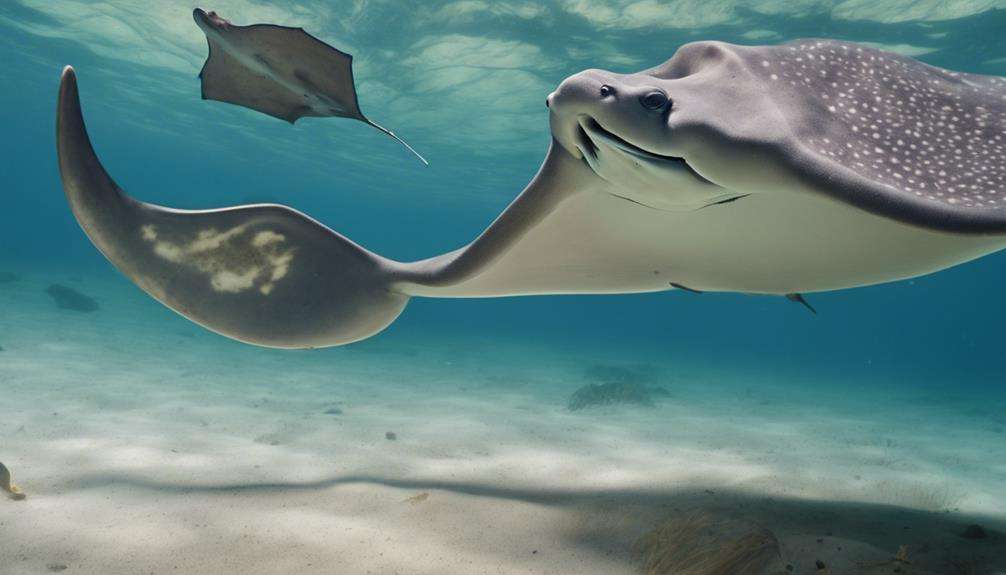
Female freshwater stingrays exhibit a considerable size difference compared to males, with females growing to sizes exceeding 6 feet in width, while males typically reach only 2-3 feet in width. This significant size dimorphism is a notable trait among freshwater stingrays, possibly linked to their reproductive strategies.
In addition to their size advantage, female freshwater stingrays also tend to have longer lifespans than their male counterparts.
Gender Size Difference
In freshwater stingrays, the size difference between genders, known as sexual dimorphism, plays a significant role in reproductive strategies and behaviors. Female freshwater stingrays exhibit a notable size advantage over males, reaching widths of up to 6.5 feet, while males typically grow to about 4.5 feet.
This disparity is paramount for reproduction, as the larger size of female stingrays allows them to carry and deliver larger offspring. In contrast, male stingrays focus on reproductive behaviors like courtship displays and mating rituals.
Scientists study this gender size difference to gain insights into the behavior, ecology, and reproductive strategies of freshwater stingrays in their natural environments. Understanding these dynamics is essential for conserving and managing stingray populations effectively.
Sexual Dimorphism in Size
The noticeable size difference between male and female freshwater stingrays, particularly in their widths, reflects significant sexual dimorphism within the species.
Female freshwater stingrays can grow up to 50% larger than males, a substantial gap attributed to reproductive strategies and roles.
This size dimorphism suggests that larger female stingrays may have advantages in both reproduction and resource acquisition.
The evolutionary biology of freshwater stingrays can be better understood by examining sexual dimorphism in size, shedding light on the intricate mechanisms at play within these fascinating creatures.
Controversy of Touch Tanks
Touch tanks featuring freshwater stingrays have ignited a contentious debate over the ethical considerations surrounding direct interactions with these aquatic animals. Concerns about stress and welfare have been raised regarding stingrays kept in touch tanks. Some argue that these animals may experience negative impacts on their health and well-being due to the artificial environment and constant human contact.
The debate revolves around the ethical implications of allowing visitors to have direct contact with stingrays in such settings. Organizations like PETA have been vocal about the potential harm touch tanks can cause to stingrays. Advocates emphasize the importance of responsible interactions with these animals to ascertain their welfare and contribute to their conservation.
It's essential for facilities housing stingrays in touch tanks to carefully consider the impact of these interactions on the animals' physical and psychological health. Balancing educational opportunities with animal welfare concerns is key in addressing the controversy surrounding touch tanks with freshwater stingrays.
Venomous Properties
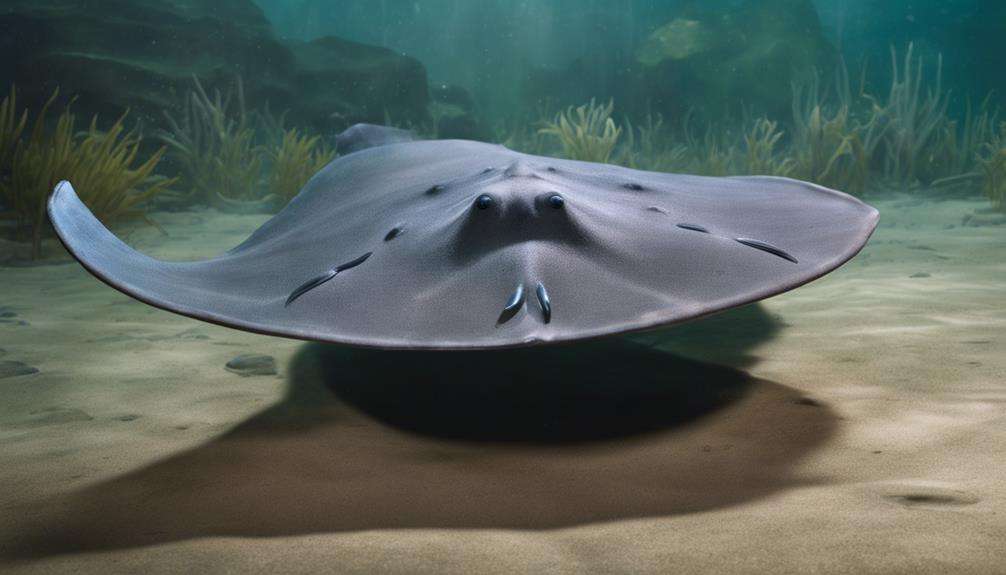
Freshwater stingrays possess venomous spines on their tails, which are equipped with a potent cocktail of proteins and peptides. When threatened, these stingrays can inject their venom through a sharp barb, causing severe pain and tissue damage in their prey.
Understanding the composition and effects of this venom is essential in appreciating the defensive mechanisms of freshwater stingrays.
Stingray Venom Composition
Comprising proteins and peptides, freshwater stingray venom possesses potent properties that induce pain, inflammation, and tissue damage. This venom also contains neurotoxins that target nerve function, potentially leading to paralysis in severe envenomation cases.
Enzymes present in the venom play a role in breaking down cell membranes, disrupting normal physiological processes within the body. Additionally, freshwater stingray venom has the capability to trigger allergic reactions in certain individuals.
It's important to note that the composition of venom can vary among different species of stingrays, impacting the severity of the effects experienced post-envenomation. Understanding the complex composition of freshwater stingray venom is critical for developing effective treatments for stingray-related injuries.
Effects on Prey
When hunting, freshwater stingrays utilize their venomous spines to immobilize and subdue their prey efficiently. The venom injected through these spines is a vital weapon that causes intense pain and tissue damage in their prey.
This venom is essential for freshwater stingrays to capture and consume their prey effectively. Once the venom enters the prey's system, it quickly immobilizes them, making it easier for the stingray to secure its meal.
The intense pain inflicted by the venom guarantees that the prey is incapacitated swiftly, allowing the stingray to feed without resistance. The evolution of these venomous properties in freshwater stingrays highlights their efficient hunting strategies and adaptation to thrive in their aquatic environments.
Sand Burrowing Habits
Sand burrowing is a common behavior observed in freshwater stingrays, allowing them to hide and rest in sandy river bottoms. Freshwater stingrays exhibit this burrowing behavior as a survival mechanism, utilizing their unique camouflaging abilities to blend seamlessly with the sandy riverbeds and evade potential threats from predators.
By burrowing into the sand, these stingrays can stay hidden and safe, reducing the risk of detection. This behavior not only serves as a form of protection but also enables them to conserve energy while in a state of rest, pivotal for their overall well-being.
In shallow riverbeds, freshwater stingrays may create burrows to seek shelter and protection, further emphasizing the significance of this adaptive behavior in their natural habitat. Through sand burrowing habits, freshwater stingrays have evolved a remarkable strategy to enhance their survival in the dynamic freshwater environments they inhabit.
Diverse Stingray Species
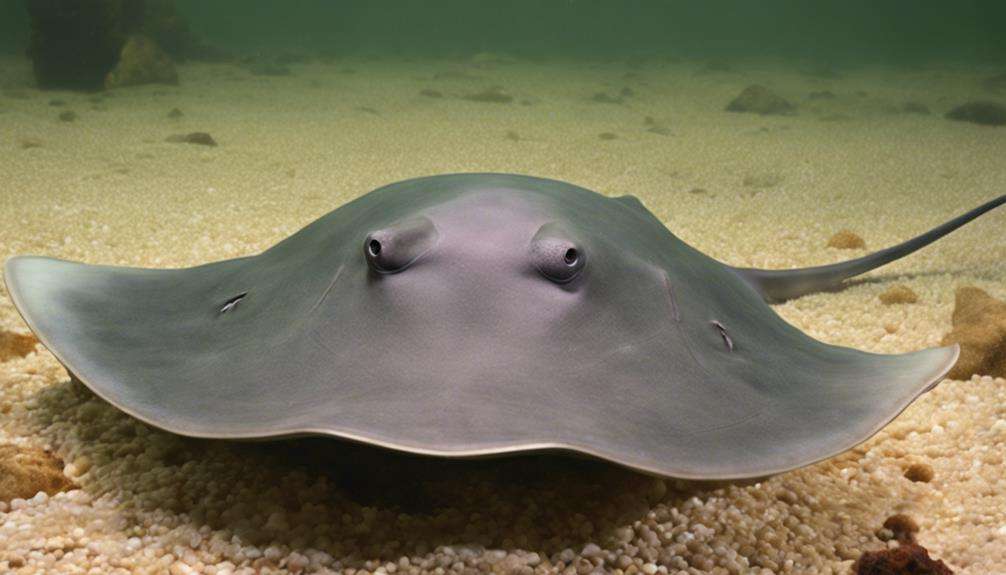
Among the vast array of freshwater stingrays, each species exhibits distinctive characteristics and adaptations tailored to their specific habitats and environmental demands. With over 70 species inhabiting rivers and lakes across South America, Africa, Asia, and Australia, freshwater stingrays showcase a remarkable diversity.
These stingrays vary in size, coloration, and behavior, reflecting their adaptation to different ecosystems. For instance, the Amazonian stingray has specialized gill structures that allow for efficient oxygen extraction in low-oxygen environments, enabling it to thrive in challenging river conditions. The diverse colorations and patterns seen in freshwater stingrays serve both as camouflage and species identification mechanisms, aiding in their survival.
Morphologically, certain species, like those in the Potamotrygonidae family, exhibit unique features such as circular disc shapes and reduced tail lengths, distinguishing them from other stingray groups. The sheer variety of freshwater stingray species underscores their evolutionary success and ability to occupy a wide range of aquatic habitats.
Food Consumption Behavior
Freshwater stingrays exhibit a carnivorous diet, primarily preying on small fish, crustaceans, and mollusks within their aquatic habitats. Their feeding habits are facilitated by specialized organs called electroreceptors, which enable them to detect the electrical signals produced by their prey. Once located, freshwater stingrays use their powerful jaws to crush and consume the food. In addition to hunting for larger prey, some species of freshwater stingrays also engage in filter feeding to extract plankton from the water for nutritional intake.
Understanding the food consumption behavior of freshwater stingrays is pivotal for conservation efforts. By studying their feeding habits, researchers can gain insights into the ecological roles these creatures play in maintaining the balance of freshwater ecosystems. Conservation initiatives can then be tailored to guarantee the survival of freshwater stingrays and the preservation of their habitats. Protecting these fascinating carnivores is essential for the overall health of freshwater environments and the biodiversity they support.
Frequently Asked Questions
What Are 5 Interesting Facts About Stingrays?
Stingrays exhibit unique behaviors like camouflage for predator evasion. They prefer diverse habitats, adapting to freshwater and saltwater. Conservation efforts are essential for their survival. Their flat bodies and venomous spines contribute to their fascinating traits.
Do Stingrays Have Any Unusual Features or Abilities?
Stingrays possess unique abilities. They camouflage to blend in their freshwater homes, have electric sensors to detect prey, and exhibit fascinating feeding habits. These features make them intriguing creatures to observe in their natural environment.
Can You Touch a Freshwater Stingray?
You shouldn't touch freshwater stingrays to protect their well-being. Direct contact can stress them, altering their behavior. Stingrays sense touch and may react defensively. Facilities may offer supervised touch experiences following guidelines for conservation. Respect their habitat.
Do Freshwater Stingrays Have Teeth?
Freshwater stingrays possess specialized crushing plates in their mouths instead of traditional teeth. These plates aid in crushing and grinding their food, reflecting their carnivorous diet and feeding habits in freshwater habitats.
Conclusion
Now that you have learned 10 fascinating facts about freshwater stingrays, you can appreciate their unique characteristics and importance in the ecosystem.
Remember, 'knowledge is power' when it comes to understanding and protecting these elusive and endangered creatures.
Keep exploring and studying the world of freshwater stingrays to contribute to their conservation and preservation.
